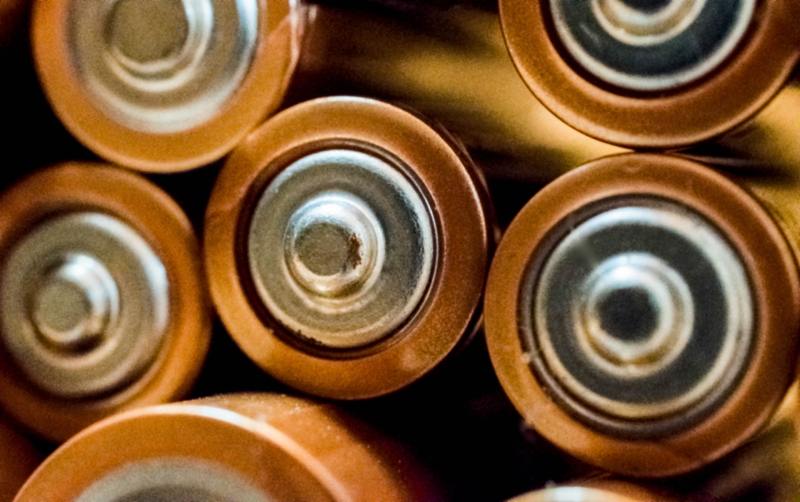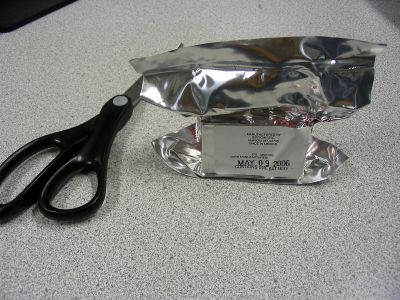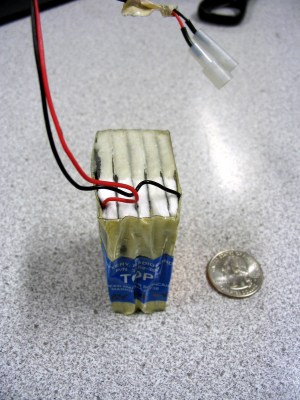
Most of the batteries we use these days, whether rechargeable or not, are generally self-contained affairs. They come in a sealed package, with the anode, cathode, and electrolyte all wrapped up inside a stout plastic or metal casing. All the reactive chemicals stay inside.
However, a certain class of magnesium batteries are manufactured in a dry, unreactive state. To switch these batteries on, all you need to do is add water! Let’s take a look at these useful devices, and explore some of their applications.
Just Add Water

Magnesium water-activated batteries come in a variety of types and formats, but the various styles available all share some common attributes. They all use a magnesium anode, and rely on aqueous solutions as the electrolyte. Typical selections involve fresh water or seawater, though custom preparations can be used to vary the battery’s performance characteristics.
The main benefit of these batteries is that they can be produced in an entirely “dry” fashion. The magnesium anode and the various salt cathodes used are all solid-state materials. Without the water electrolyte in place, they can happily sit on the shelf for years without degrading. That’s a big benefit over the traditional batteries we use every day, which start the self-discharge process as soon as they’re manufactured. Magnesium batteries inherently have high self-discharge, too, but without the electrolyte in place, the battery isn’t complete, and it simply doesn’t happen. However, this does mean they’re single-use batteries that typically run for minutes to hours at the most.
The batteries are available in a range of chemistries, with magnesium-silver chloride batteries the best choice for performance applications. In practice, they typically offer power densities of up to 100 to 150 Wh/kg, on a par with lithium ion batteries, which can deliver 100 to 265 Wh/kg. Alternative chemistries are often chosen for their lower cost, with copper chloride and lead chloride among the more commonly used. Cells built with these cathode materials are much cheaper thanks to the lack of silver content, but can’t deliver the same power. Typically, they come in around 50 to 80 Wh/kg, and can’t deliver the same current as silver chloride-based cells. Depending on the chemistry, open-circuit voltages range from approximately 1.0 to 1.7 V, with higher voltages achieved by stacking many cells together.
Different Configurations

Water can be added to the battery in a variety of ways, depending on the desired application. So-called “dunk” batteries have the anodes and cathodes separated by porous, absorbent membranes. They can simply be dunked in a bucket of water to activate them, or filled with water manually, and typically run for several hours. Dunk batteries are often used on radiosondes and other equipment that benefits from a battery design with great shelf life and no heavy metal content, as they often end up left in the environment.
They’re generally stored in hermetically-sealed packs with a dessicant for good measure. When needed, the pack can be opened, and the battery juiced up, and it’s ready to go. They’ll run as long as the electrolyte is present or the cathode and andoe have ions left to give.
When used in extreme conditions, the electrolyte can boil off or freeze, and the battery will cease to deliver electricity. However, the heat generated from the battery’s own chemical reaction can sometimes provide enough heat to stave off freezing, making these batteries capable in low temperature conditions.
Immersion batteries are intended for use fully-submerged, as their name implies. Applications typically involve equipment for maritime emergencies. In these roles, the long stable shelf-life pays off, and there’s typically abundant water around to serve as an electrolyte. They’re commonly used to power emergency lights on life jackets carried in airliners, with a small quantity of salt often included in the battery to enable good performance even if the wearer lands in a freshwater lake. Other uses include power for radios and beacons on lifeboats, as well as sonobuoys, which spend their working life underwater.

The highest-performance water-activated batteries are of the forced-flow type, primarily used to power propulsion and electronics in torpedos. These take advantage of the fact that the torpedo’s forward motion can force fresh salt water through the battery, continually replenishing the electrolyte. This also serves to cool the battery, keeping it at a stable temperature for best performance.
Forced-flow magnesium-silver chloride batteries have been built in configurations of hundreds of cells in series, delivering tens to hundreds of kilowatts of power. Run times are typically on the order of 5-15 minutes, which is usually more than long enough for a torpedo to find its target and explode. These batteries took off in earnest in the wake of World War II, though have slowly been phased out by other solutions in more modern hardware.
Other obscure uses exist for these batteries, too. Smart pills exist that feature a tiny magnesium-copper cell inside. Upon coming into contact with stomach acid, the cell begins to provide electricity to a tiny circuit that sends a radio message indicating the pill has begun digestion. The cell itself is digested like any other minerals in the stomach, and the transmitter circuit is passed out of the body as waste.
Fit For Purpose
These batteries aren’t something that most of us would use on a daily basis. Their method of activation is comparatively messy compared to conventional batteries, and most of us don’t need a battery to maintain peak performance after sitting on a shelf for five or ten years. However, in a wide range of scientific, military, and industrial contexts, they’re incredibly useful. In these contexts, where it’s important to have a battery that’s ready to go at the drop of a hat after sitting for a long time, it’s hard to argue with the capability of magnesium water-activated batteries.
Headline photo: “Close-up Photo of Batteries” by Hilary Halliwell. Thumbnail image: “dead batteries” by John Seb Barber
Thank Magnesium For Water-Activated Batteries
Source: Manila Flash Report
0 Comments